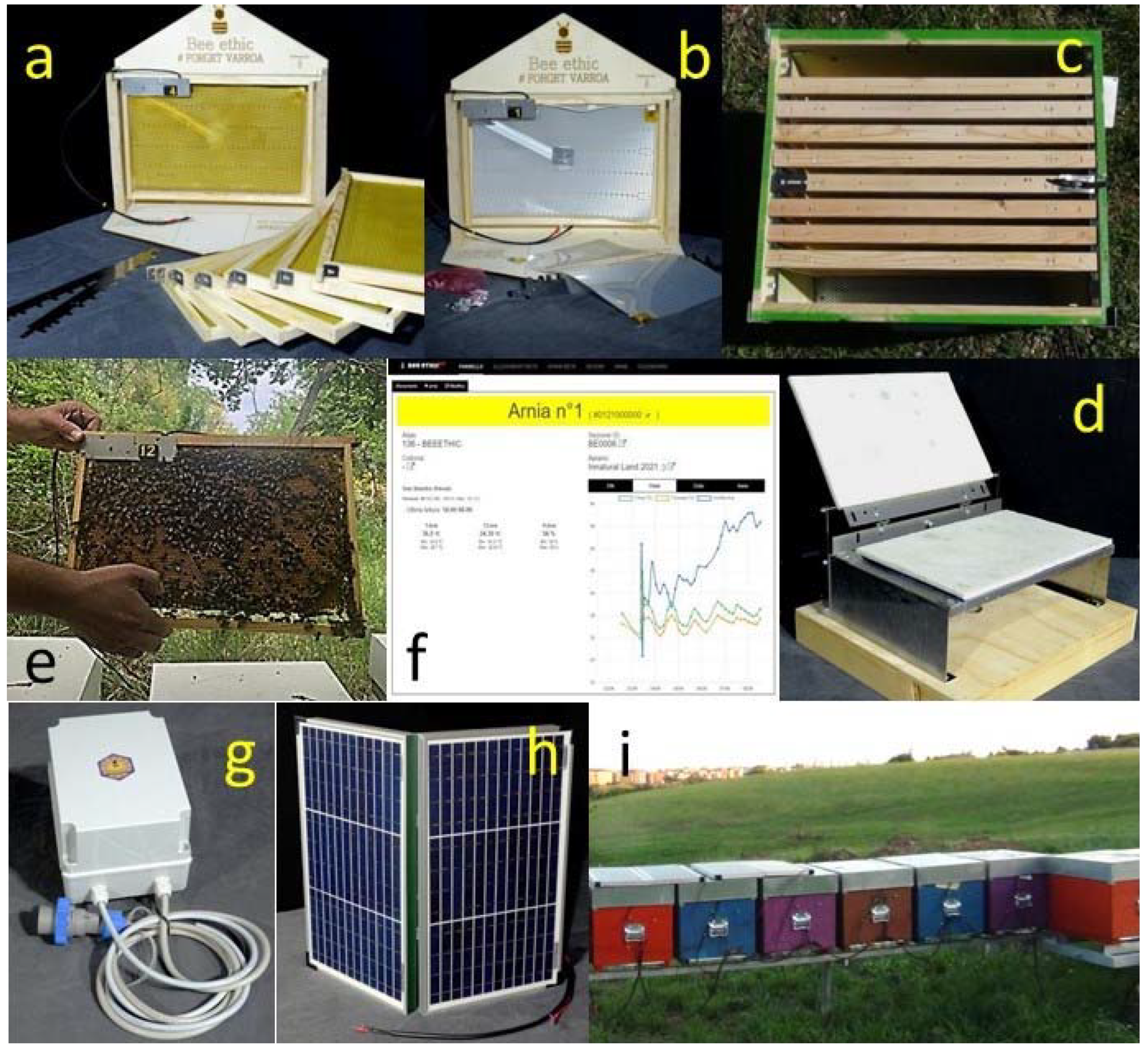Varroa Control by Means of a Hyperthermic Device
Abstract
:1. Introduction
2. Materials and Methods
2.1. The Bee Ethic System
2.2. Apiary Trials
2.3. Mathematical Model Simulations
3. Results
3.1. Apiary Trials
3.2. Mathematical Model Simulations
4. Discussion
5. Conclusions
6. Patents
Supplementary Materials
Author Contributions
Funding
Institutional Review Board Statement
Informed Consent Statement
Data Availability Statement
Acknowledgments
Conflicts of Interest
References
- Spivak, M. Honey bee hygienic behavior and defense against Varroa jacobsoni. Apidologie 1996, 27, 245–260. [Google Scholar] [CrossRef]
- Traynor, K.S.; Mondet, F.; de Miranda, J.R.; Techer, M.; Kowallik, V.; Oddie, M.A.Y.; Chantawannakul, P.; McAfee, A. Varroa destructor: A Complex Parasite, Crippling Honey Bees Worldwide. Trends Parasitol. 2020, 36, 592–606. [Google Scholar] [CrossRef] [PubMed]
- Grozinger, C.M.; Flenniken, M.-L. Bee Viruses: Ecology, Pathogenicity, and Impacts. Annu. Rev. Entomol. 2019, 64, 205–226. [Google Scholar] [CrossRef] [PubMed]
- Flores, J.M.; Gámiz, V.; Jiménez-Marín, A.; Flores-Cortés, A.; Gil-Lebrero, S.; Garrido, J.J.; Hernando, M.D. Impact of Varroa destructor and associated pathologies on the colony collapse disorder affecting honey bees. Res. Vet. Sci. 2021, 135, 85–95. [Google Scholar] [CrossRef] [PubMed]
- Genersch, E.; von der Ohe, W.; Kaatz, H.; Schroeder, A.; Otten, C.; Büchler, R.; Berg, S.; Ritter, W.; Mühlen, W.; Gisder, S.; et al. The German bee monitoring project: A long term study to understand periodically high winter losses of honey bee colonies. Apidologie 2010, 41, 332–352. [Google Scholar] [CrossRef]
- Imdorf, A.; Charriere, J.D.; Kilchenmann, V.; Bogdanov, S.; Fluri, P. Alternative strategy in central Europe for the control of Varroa destructor in honey bee colonies. Apiacta 2003, 38, 258–278. [Google Scholar]
- Jack, C.J.; Ellis, J.D. Integrated Pest Management Control of Varroa destructor (Acari: Varroidae), the Most Damaging Pest of Apis mellifera L. (Hymenoptera: Apidae) Colonies. J. Insect Sci. 2021, 21, 6. [Google Scholar] [CrossRef] [PubMed]
- Goras, G.; Tananaki, C.; Gounari, S.; Dimou, M.; Lazaridou, E.; Karazafiris, E.; Kanelis, D.; Liolios, V.; El Taj, H.; Thrasyvoulou, A. Hyperthermia—A non-chemical control strategy against varroa. J. Hell. Vet. Med. Soc. 2018, 66, 249–256. [Google Scholar] [CrossRef]
- Engels, W. Efficiency of biotechnical control of varroasis, by means of hyperthermia. Apiacta 1998, 33, 49–55. [Google Scholar]
- Kablau, A.; Berg, S.; Rutschmann, B.; Scheiner, R. Short-term hyperthermia at larval age reduces sucrose responsiveness of adult honeybees and can increase life span. Apidologie 2020, 51, 570–582. [Google Scholar] [CrossRef]
- Tihelka, E. History of Varroa Heat Treatment in Central Europe (1981–2013). Bee World 2016, 93, 4–6. [Google Scholar] [CrossRef]
- Bičík, V.; Vagera, J.; Sádovská, H. The effectiveness of thermotherapy in the elimination of Varroa destructor. Acta Mus. Sil. Sci. Nat. 2016, 65, 263–269. [Google Scholar] [CrossRef]
- Huang, Z. Mite Zapper—A New and Effective Method for Varroa Mite Control. Am. Bee J. 2001, 140, 730–732. [Google Scholar]
- Vatorex. Available online: watorex.com (accessed on 9 June 2022).
- Delaplane, K.S.; Van Der Steen, J.; Guzman-Novoa, E. Standard methods for estimating strength parameters of Apis mellifera colonies. J. Apic. Res. 2013, 52, 1–12. [Google Scholar] [CrossRef]
- Amsler, T.; Schmid, L. Controllo Della Varroa in Apicoltura Biologica; Forschungsinstitut für Biologischen Landbau (FiBL): Frick, Switzerland, 2010; 4p, Available online: https://orgprints.org/id/eprint/18018/1/amsler-schmid-2010-varroase.pdf (accessed on 9 June 2022).
- Rinderer, T.E.; De Guzman, L.I.; Frake, A.M.; Tarver, M.R.; Khongphinitbunjong, K. An Evaluation of the Associations of Parameters Related to the Fall of Varroa destructor (Acari: Varroidae) From Commercial Honey Bee (Hymenoptera: Apidae) Colonies as Tools for Selective Breeding for Mite Resistance. J. Econ. Entomol. 2014, 107, 516–522. [Google Scholar] [CrossRef] [PubMed]
- Floris, I. Dispersion indices and sampling plans for the honeybee (Apis mellifera ligustica Spin.) mite Varroa jacobsoni Oud. Apicoltura 1991, 7, 161–170. [Google Scholar]
- Becher, M.A.; Grimm, V.; Thorbek, P.; Horn, J.; Kennedy, P.J.; Osborne, J.L. BEEHAVE: A systems model of honeybee colony dynamics and foraging to explore multifactorial causes of colony failure. J. Appl. Ecol. 2013, 51, 470–482. [Google Scholar] [CrossRef] [PubMed]
- Kablau, A.; Berg, S.; Härtel, S.; Scheiner, R. Hyperthermia treatment can kill immature and adult Varroa destructor mites without reducing drone fertility. Apidologie 2020, 51, 307–315. [Google Scholar] [CrossRef]
- Peck, D.T.; Seeley, T.D. Mite bombs or robber lures? The roles of drifting and robbing in Varroa destructor transmission from collapsing honey bee colonies to their neighbors. PLoS ONE 2019, 14, e0218392. [Google Scholar] [CrossRef] [PubMed]
- Marti, S.J. Ontogenesis of the mite Varroa jacobsoni Oud. in worker brood of the honeybee Apis mellifera L. under natural conditions. Exp. Appl. Acarol. 1994, 18, 87–100. [Google Scholar] [CrossRef]










| Adults | Juveniles | |
|---|---|---|
| 2018 | 43.5% | 85.3% |
| 2020 | 25.8% | 93.0% |
| 2021 | 24.8% | 79.9% |
Publisher’s Note: MDPI stays neutral with regard to jurisdictional claims in published maps and institutional affiliations. |
© 2022 by the authors. Licensee MDPI, Basel, Switzerland. This article is an open access article distributed under the terms and conditions of the Creative Commons Attribution (CC BY) license (https://creativecommons.org/licenses/by/4.0/).
Share and Cite
Porporato, M.; Manino, A.; Cuttini, D.; Lorenzon, S.; Ciaudano, S.; Parodi, V. Varroa Control by Means of a Hyperthermic Device. Appl. Sci. 2022, 12, 8138. https://doi.org/10.3390/app12168138
Porporato M, Manino A, Cuttini D, Lorenzon S, Ciaudano S, Parodi V. Varroa Control by Means of a Hyperthermic Device. Applied Sciences. 2022; 12(16):8138. https://doi.org/10.3390/app12168138
Chicago/Turabian StylePorporato, Marco, Aulo Manino, Davide Cuttini, Simone Lorenzon, Silvia Ciaudano, and Valerio Parodi. 2022. "Varroa Control by Means of a Hyperthermic Device" Applied Sciences 12, no. 16: 8138. https://doi.org/10.3390/app12168138
APA StylePorporato, M., Manino, A., Cuttini, D., Lorenzon, S., Ciaudano, S., & Parodi, V. (2022). Varroa Control by Means of a Hyperthermic Device. Applied Sciences, 12(16), 8138. https://doi.org/10.3390/app12168138






